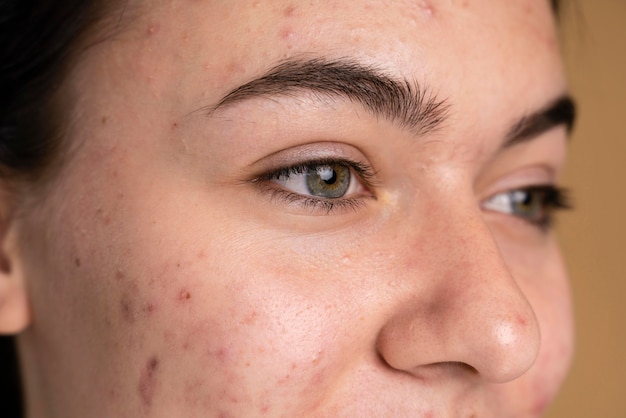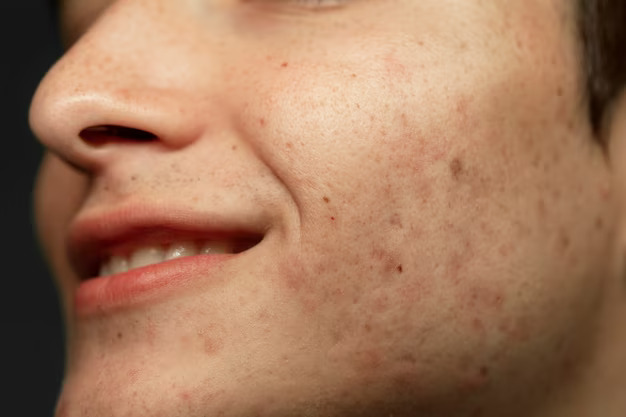Post-inflammatory erythema, commonly called PIE, is a dermatological condition characterised by reddish or purplish discolouration of the skin following inflammation or acne. These flat, reddish spots, typically found on the face, occur due to damage to the capillaries (tiny blood vessels) near the skin surface.
Unlike post-inflammatory hyperpigmentation (PIH), PIE markings do not darken with sun exposure and can appear more pronounced when pressed with clear glass – a diagnostic method known as diascopy. It’s important to remember that while PIE often improves with time, it can be a persistent and distressing condition for many.
This post will delve into the causes, treatment options, and prevention tips for post-inflammatory erythema to give a better understanding of this skin condition.
Contents
- 1 What is Post-Inflammatory Erythema (PIE)?
- 2 Post-Inflammatory Erythema vs. Post-Inflammatory Hyperpigmentation
- 3 What Causes Post-Inflammatory Erythema?
- 4 Signs and Symptoms
- 5 Types of Post-Inflammatory Erythema
- 6 Diagnosis and Evaluation
- 7 Post-Inflammatory Erythema Treatment Options
- 8 How Can Post-Inflammatory Erythema Be Prevented?
- 9 Living with Post-Inflammatory Erythema
- 10 Complications and Follow-Up
- 11 How Long Does Post-Inflammatory Erythema Typically Last?
- 12 Does Post-Inflammatory Erythema Leave Permanent Skin Damage?
- 13 Conclusion
What is Post-Inflammatory Erythema (PIE)?
Post-Inflammatory Erythema (PIE) is a type of skin discolouration resulting from inflammation or injury, especially after an acne breakout. When the skin experiences trauma, it triggers a response from the body to increase blood flow to the affected area for healing. In the case of PIE, this heightened blood supply leads to a visible red or purplish hue on the skin surface, indicating where the inflammation once was. These discolourations are flat and often look like a rash. Although PIE is not harmful or contagious, it can be a significant cosmetic concern for people who have it, leading to lowered self-esteem and social anxiety.
Post-Inflammatory Erythema vs. Post-Inflammatory Hyperpigmentation
Post-Inflammatory Erythema and Post-Inflammatory Hyperpigmentation are two common skin conditions that are often confused. Here’s how they differ:
Appearance
Both PIE and PIH result in changes to the skin’s colour following inflammation. PIE manifests as flat, pink or red marks or purplish marks, which do not darken with sun exposure. In contrast, PIH presents brown or black spots on the skin that may darken when exposed to the sun.
Underlying Mechanisms
PIE arises due to damage to the capillaries near the skin’s surface, leading to an increased blood supply to the affected area. On the other hand, PIH occurs due to an overproduction of melanin, the pigment responsible for skin colour, as a response to skin inflammation.
Causes and Triggers
Both PIE and PIH are typically triggered by skin inflammation or injury. In particular, serious acne scars and breakouts are a common cause of both conditions. However, other skin inflammation types, such as burns or dermatitis, can also lead to PIE or PIH.
Treatment Approaches
There are differing treatment methods for PIE and PIH due to their distinct underlying mechanisms. Treatments for PIE generally aim to reduce redness and inflammation and may include pulsed-dye lasers or silicone sheets. In contrast, treatments for PIH focus on reducing melanin production and may include topical treatments like retinoids and hydroquinone, chemical peels, or laser therapy.
What Causes Post-Inflammatory Erythema?

Some various causes and triggers can lead to post-inflammatory erythema. Understanding these contributors can aid in the prevention and management of this skin condition.
Acne – One of the most common causes of PIE. When acne significantly inflames the skin, it can damage the capillaries underneath, leading to PIE.
Skin Injuries – Any form of physical trauma to the skin, such as cuts, burns, or abrasions, can result in PIE. The trauma-induced inflammation causes heightened blood flow to the impacted area, leading to reddish or purplish discolouration.
Allergic Reactions – Allergic reactions that cause skin inflammation, such as contact dermatitis or hives, can also lead to PIE. These reactions cause the body to increase blood flow to the affected skin areas, potentially resulting in PIE.
Dermatological Procedures – Certain skincare treatments, including chemical peels or dermabrasion, can cause skin inflammation and may result in PIE post-procedure. It’s important for individuals undergoing these procedures to follow their dermatologist’s aftercare instructions to minimise the risk of developing PIE.
Signs and Symptoms
Post-inflammatory erythema primarily manifests as red or pink patches on the skin. These patches are flat, not raised, and retain a consistent hue that does not darken with sun exposure or under pressure—the distinct colouration results from damaged capillaries near the skin’s surface.
A key identifier of PIE is persistent erythema, where the redness remains even after the initial skin condition, such as acne or a skin injury, has resolved. This lingering redness is a response to inflammation. It can last anywhere from several weeks to a few years, depending on the severity of the initial skin trauma and the individual’s skin healing capabilities.
Another symptom associated with PIE is sensitivity or tenderness in the affected areas. The skin may be uncomfortable or sore to the touch, particularly in the condition’s early stages. This is due to the increased blood flow to the area during the healing process. However, PIE itself is not a painful condition, and any pain likely stems from the primary skin condition that led to the development of PIE.
It’s worth noting that not all redness on the skin after inflammation indicates PIE. Other skin conditions can also cause redness, such as rosacea or keratosis pilaris.
Types of Post-Inflammatory Erythema
Post-Inflammatory Erythema can present in several forms, each with its unique characteristics.
Erythematous Macules – These are small, flat red or pink spots on the skin that are usually less than 1 centimetre in diameter. They result from damage to the capillaries near the skin’s surface and are a common manifestation of PIE following acne or minor skin injuries.
Erythematous Papules – These are slightly raised bumps on the skin, again with a red or pink hue. Erythematous papules are usually less than 1 centimetre in diameter but are distinguishable by their raised nature. They can be a result of more significant skin trauma or inflammation, such as severe acne lesions or allergic reactions.
Erythematous Patches – These are larger areas of red or pink discolouration on the skin, usually greater than 1 centimetre in diameter. Erythematous patches might occur after extensive skin inflammation or injury, and their larger size can make them more noticeable and potentially distressing for individuals affected.
Diagnosis and Evaluation
Dermatologists diagnose Post-Inflammatory Erythema (PIE) through a clinical evaluation and review of the patient’s medical history. During the evaluation, the dermatologist examines the patient’s skin, paying attention to red or pink discolouration areas. Pressure on the skin reveals a blanching characteristic. The medical history includes questions about previous skin conditions, injuries, or procedures that may have caused inflammation. Additional tests may be needed to differentiate PIE from other skin conditions.
Post-Inflammatory Erythema Treatment Options

1. Topical Treatments
Azelaic Acid, Niacinamide, and Anti-Inflammatory Creams are effective solutions for managing Post-Inflammatory Erythema (PIE). Azelaic acid, a dicarboxylic acid, reduces inflammation and promotes healthy skin cell growth, making it valuable for PIE and acne. With its anti-inflammatory properties, Niacinamide, or vitamin B3, minimizes redness and enhances skin resilience, often found in serums and creams.
Topical anti-inflammatory creams containing ingredients like corticosteroids can also reduce redness but should be used under dermatologist guidance due to potential side effects.
2. Laser and Light Therapies
Laser and light therapies, like pulsed dye lasers (PDL) and intense pulsed light (IPL), are effective for treating Post-Inflammatory Erythema (PIE). PDL targets superficial capillaries with a concentrated light beam, reducing redness and inflammation. PDL can be customized based on erythema severity and skin type, requiring multiple sessions for optimal results.
IPL uses broad-spectrum light to target various skin chromophores. It reduces vascular redness, improves darker skin tones and texture, and addresses pigmentation issues and sun damage. Although not a laser, IPL offers versatility for treating a wider range of skin concerns.
Trained professionals should perform PDL and IPL to reduce inflammation and minimize side effects. Post-treatment care is crucial for maintaining results and preventing further inflammation.
3. Chemical Peels
Chemical peels, like those with alpha-hydroxy acids (AHAs) such as glycolic acid and lactic acid, can be beneficial for treating post-inflammatory erythema (PIE). AHAs exfoliate the skin, promoting the growth of healthier skin by removing dead skin cells. These peels dissolve the ‘glue’ that binds skin cells, revealing a smoother texture and helping to even out skin tone and reduce redness.
AHAs also stimulate cellular regeneration and collagen production, repairing damaged blood vessels and reducing the appearance of PIE. However, using chemical peels under professional guidance is important to prevent skin irritation or damage.
4. Microneedling
Microneedling effectively treats Post-Inflammatory Erythema (PIE) by creating controlled micro-injuries on the skin. This stimulates natural wound healing, boosting collagen and elastin production for improved skin elasticity, firmness, and texture.
It also enhances the absorption of topical treatments, accelerates healing, and reduces erythema when combined with topical treatments. Microneedling promotes new skin cell regeneration, improving skin texture over time.
However, it’s crucial to have microneedling performed by skilled professionals and follow proper aftercare. Avoid harsh skincare products and sun exposure, as the skin may be sensitive post-treatment. Consult a dermatologist to determine suitability for your case of PIE.
How Can Post-Inflammatory Erythema Be Prevented?
To prevent Post-Inflammatory Erythema (PIE), it’s essential to maintain a gentle skincare regimen. Use mild, fragrance-free cleansers and hydrating, non-comedogenic moisturisers to avoid pore blockage. Limit exfoliation, opting for milder ingredients like lactic acid to minimise irritation. Refrain from picking at acne, as it can lead to PIE; seek a dermatologist for proper treatment. Protect your skin from the sun with broad-spectrum SPF 30+ sunscreen, hats, and sunglasses, even in cloudy weather. Consistent application of these measures can significantly lower the risk of PIE development.
Living with Post-Inflammatory Erythema

Living with Post-Inflammatory Erythema (PIE) can be challenging, but there are ways to manage its appearance daily. One effective method is using non-comedogenic, hypoallergenic makeup to conceal the redness. Start with a green-tinted primer to neutralise redness, then apply a matching foundation. A mineral-based foundation can provide coverage without clogging pores or causing irritation.
Concealers with salicylic acid or Niacinamide can treat acne inflammation while providing coverage. Gently dab the concealer onto the affected areas using your fingertips or a soft brush. Finish with loose powder to set the makeup. Remember to remove all makeup at the end of the day and follow a gentle skincare routine.
Complications and Follow-Up
While Post-Inflammatory Erythema (PIE) treatments are generally safe, they carry potential risks. For example, if incorrectly done, chemical peels and micro-needling could cause skin irritation, infections, or scarring. Darker skin types are at a higher risk of hyperpigmentation. It’s crucial to have these treatments done by trained professionals and follow recommended aftercare.
PIE can recur if the skin is exposed to the same conditions that caused it initially, such as acne. Establishing a consistent skincare routine and taking preventive measures are important for keeping the skin healthy and inflammation-free.
Treatments can help manage PIE but may not provide a permanent solution. The effectiveness of treatments varies from person to person, and PIE may persist even after treatment. However, consistent skincare and professional treatments can significantly reduce the appearance of PIE over time.
Regular follow-ups with a dermatologist are advisable to monitor progress, adjust treatment plans, and manage potential side effects. Finding what works best for your skin may take time and experimentation. Be patient and seek professional help when needed.
How Long Does Post-Inflammatory Erythema Typically Last?
The duration of post-Inflammatory Erythema (PIE) varies based on initial inflammation severity and skincare practices. Mild cases fade in weeks or months, while severe or persistent cases can last months to a year or longer.
Does Post-Inflammatory Erythema Leave Permanent Skin Damage?
Post-inflammatory erythema (PIE) doesn’t typically cause permanent skin damage. It’s a superficial condition with red or purple discolouration. This results from capillary damage near the skin’s surface due to inflammation. While it can persist, it usually doesn’t leave permanent acne scars or changes in skin texture. However, if PIE is associated with severe acne or other scarring skin conditions, residual marks or texture changes may occur after the erythema subsides. Various treatments, consistent skincare routines, and sun protection can effectively manage PIE and limit long-term effects.
Conclusion
Post-Inflammatory Erythema (PIE) is a skin condition characterised by red or purple discolouration following inflammation, commonly due to acne. While PIE does not typically lead to permanent skin damage, it can persist, largely depending on the severity of the initial skin inflammation and subsequent skincare practices.
Various treatments, including laser therapy, chemical peels, and topical creams, are available, and their effectiveness can vary from person to person. Counteracting the appearance of PIE can also be achieved through makeup techniques and a consistent skincare routine. Despite the potential for recurrence, PIE can be effectively managed with professional help, diligent skincare, and sun protection.
Lastly, it’s crucial to remember that everyone’s skin is unique, and patience is key in dealing with PIE. If you’re concerned about the condition or its impact on your life, it’s advisable to consult with a dermatologist.





